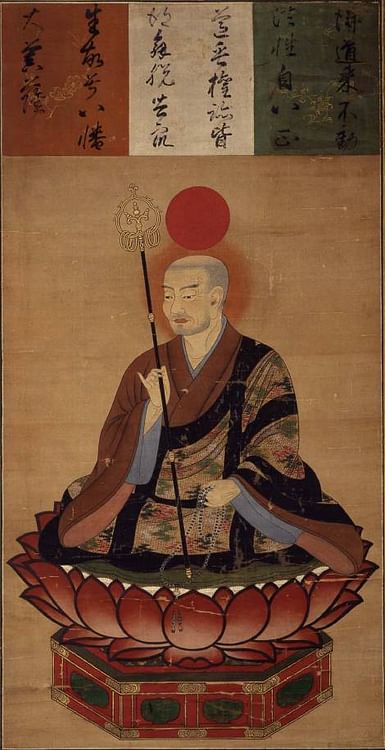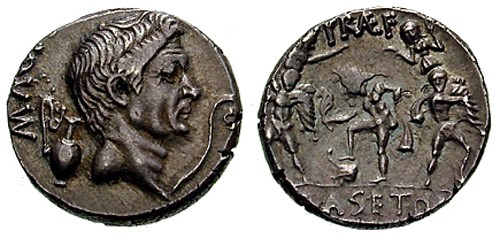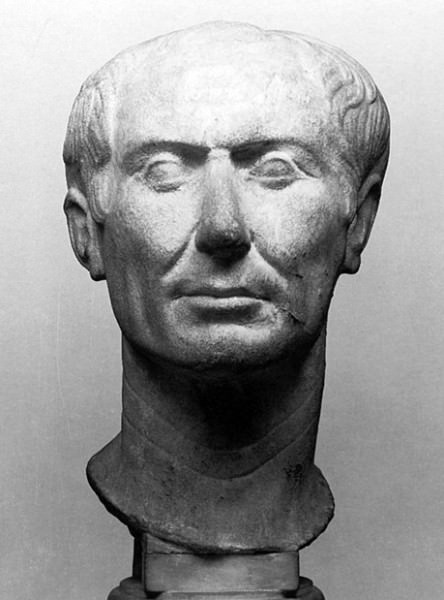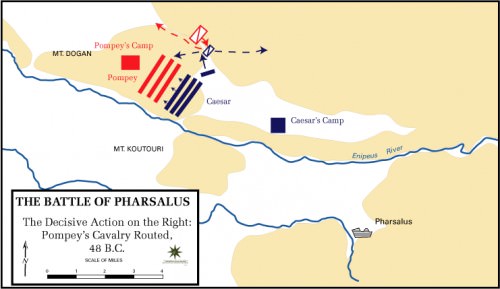Hachiman › The Battle of Pharsalus » Origins and History
Articles and Definitions › Contents
- Hachiman › Antique Origins
- The Battle of Pharsalus › Antique Origins
Ancient civilizations › Historical places, and their characters
Hachiman › Antique Origins
Definition and Origins

Hachiman is the ancient Shinto god or kami of war, divination, and culture. He is famously credited with sending the kamikaze or 'divine wind' which twice dispersed the invading fleets of Mongol ruler Kublai Khan in the 13th century CE and which earned Hachiman the title of protector of Japan. In the typical crossover seen in Shinto and Buddhism in ancient Japan, Hachiman is also considered a bodhisattva and protector of temples. The god was and continues to be worshipped at thousands of shrines of both faiths around the country, including the Todaiji in Nara and Hachiman shrine in Kamakura.
HISTORICAL ASSOCIATIONS
Hachiman grew in importance during the latter half of the Heian Period (794-1185 CE) when many Buddhist shrines were established in his honour. The kami or spirit of Hachiman, especially the aspect representing culture, was particularly associated with two semi-legendary rulers: Empress Jingu and her son the deified Emperor Ojin (r. 270-310 CE); both were thought to have been avatars of Hachiman such were their great feats in warfare and culture in general - Jingu for invading Korea, and Ojin for inviting Chinese and Korean scholars to Japan. The first link between Hachiman and Emperor Ojin, figures which often become interchangeable in later times, appears in the Hachimangu mirokuji engi, composed c. 840 CE.
In the 11th century CE, Hachiman was selected as the symbolic head and patron of the powerful Minamoto clan, who could then claim lineage back to Emperor Ojin. Yorinobu (968-1048 CE) was the first Minamoto to make this claim in 1046 CE, and his son Yoriyoshi strengthened the family ties to Hachiman by citing the god as the reason for his victory in the Earlier Nine Years War in 1062 CE against the Abe clan. Yoriyoshi built a shrine at Yui-no-go in Sagami (moved to Kamakura in 1191 CE), and from that point on ever more shrines were built, all funded and protected by the Minamoto.
HACHIMAN'S STATURE GREW IN THE KAMAKURA PERIOD WHEN HE WAS WORSHIPPED BY THE GROWING BANDS OF SAMURAI WARRIORS.
Yoriyoshi's son Yoshiie (1042-1103 CE) was an equally formidable warrior and he came to be known as Hachimantaro or 'First Son of Hachiman'. The legendary hero was named after the god following a dream by his father where Hachiman gave the youth a sword. Hachimanto was a famed archer, credited with being able to fire an arrow through three men at once and he was the main reason the Japanese defeated the Ezo people of northern Honshu.
KAMIKAZE
Hachiman's stature grew even greater in the Kamakura Period (1185-1333 CE) when he was worshipped by the growing bands of samurai warriors. Then the god enjoyed his greatest triumph when he was called upon to help save Japan as it faced its greatest ever threat from Mongol China. The god was credited with responding to these prayers and sending the kamikaze or 'divine wind', actually typhoons in the often treacherous waters between Japan and the Asian mainland, which dispersed two Mongol-Chinese-Korean invasion fleets sent by Kublai Khan in 1274 and 1281 CE. This miraculous escape from a numerically superior foe gave the Japanese priesthood plenty of ammunition for their sermons and sutras which led to a boom in conversions to Buddhism.
The notion of kamikaze, which had twice saved Japan, held such a strong hold on the public imagination that during the latter stages of WWII it was revived as the name for suicide pilots who were thought to be, like Hachiman, providing a last ditch effort to save Japan from imminent invasion.
SHRINES & WORSHIP
Hachiman was first worshipped locally and then more formally at the Shinto Usa shrine in northern Kyushu, founded in 725 CE. Quite why Usa was the first temple to honour Hachiman is not known. A figure of the god was transferred with great ceremony from Usa to the new Buddhist Todaiji monastery in Nara in 747 CE, ready to become its guardian spirit ( chinju ) when it officially opened two years later. In gratitude, the imperial court gave the Usa Hachiman shrine an exemption from taxes and a high court rank. Another important large temple complex was built in the god's honour at Iwashimizu, south of the capital Heiankyo (Kyoto) in 859 CE. A later temple but today significant is the Tomioka Hachimangu in Tokyo, founded in 1627 CE. Today there are some 25,000 Hachiman shrines across Japan.

Hachiman
The Hachiman cult, like many others, included belief in an oracle of the god in the form of female priestesses who, possessed of the kami of Hachiman, uttered sounds which were then interpreted by a male priest or saniwa. A compendium of the god's oracle proclamations, the Hachiman Usagu gotakusenshu was compiled in the 14th century CE by a Buddhist monk called Jinun.
The most famous declaration from an oracle of Hachiman was to the warrior Taira no Masakado (c. 903-940 CE). After defeating a number of warlords in the eastern provinces, Masakado made the remarkable claim in 939 CE that Hachiman had spoken to him through his oracle and declared that he should be made emperor. Naturally, the current emperor proved unwilling to step down or even share his throne and instead sent an army to defeat Masakado. The head of the 'new emperor' ( shinko ) as he called himself was sent to the capital Heiankyo and normal service resumed in the Japanese court. The tale was preserved for posterity in the mid-10th-century CE Shomonki ('The Story Of Masakado'). After this incident, Hachiman came to be considered the special protector of the imperial line.
In Buddhism Hachiman was officially made a bodhisattva, that is an enlightened one who remains on earth to guide the faithful, in 937 CE, the first of many kami from Shinto to be given that status in the crossover of faiths that was so typical of religion in ancient Japan. In time, the interpretation of Hachiman's oracular proclamations was entrusted specifically to male Buddhist monks. A celebrated wood statue of Hachiman as a bodhisattva, carved by the artist Kwaikei in 1201 CE, resides in the Todaiji monastery. Hachiman came to be worshipped not only as a daibosatsu or Great Buddha but also as the protector of Buddhist temples. In the Medieval Period Hachiman was considered an avatar of Amida (Amitabha) the Buddha of the Pure Land.
Hachiman is associated with doves, which are his messengers, and his symbol is the bow and arrow, traditional weapon of choice (and not the sword) of the ancient gentleman Japanese warrior. Consequently, the sacred object ( go- shintai ) representing the god in his shrines is usually a bow and arrow, and sometimes stirrups too. A few temples have a calligraphy brush as their go- shintai to represent the god as patron of culture. Indeed, as Hachiman is also the kami of all things cultural, his shrine complexes often include secondary shrines dedicated to Tenjin, the Shinto god of scholarship and learning.
Festivals and ceremonies still held at Hachiman shrines include the popular omiyamairi ritual where young babies, especially boys, visit a shrine for the first time in their lives and receive purification surrounded by their family. Finally, Hachiman's Buddhist connections are evidenced in the Hojo-e festival, which began in 720 CE, where the faithful release animals and fish back into the wild.
This article was made possible with generous support from the Great Britain Sasakawa Foundation.
The Battle of Pharsalus › Antique Origins
Ancient Civilizations
Pharsalus, in eastern Greece, was the site of a decisive battle in 48 BCE between two of Rome 's greatest ever generals: Pompey the Great and Julius Caesar. After several previous encounters, Pharsalus, the biggest ever battle between Romans, would finally decide which of the two men would rule the Roman world. Outnumbered in infantry and cavalry, Caesaremployed daring strategies which won him a resounding victory and, in so doing, he cemented his reputation as one of the greatest commanders in history.
PROLOGUE
The immensely popular Gnaeus Pompeius Magnus, otherwise known as Pompey the Great, had enjoyed great military successes in Sicily and Africa, he had emphatically swept the Mediterranean clear of pirates and, most impressively of all, he had defeated Mithradates VI in the east. Ruling as a triumvirate with Julius Caesar and Marcus Licinius Crassus, Pompey governed Rome's Spanish provinces whilst Caesar, now rich from his own glorious conquests, controlled Gaul. In the final years of the Roman Republic and following Crassus ' untimely death in 53 BCE, the two remaining rulers became set on a collision course to disaster.

Pompey
Pompey, always big on preparation and wary of the inevitable confrontation with Caesar, decided that his best strategy was to abandon Italy. Loyalties there were divided and the two legions present could not be trusted to face their old commander Caesar. Instead, Pompey chose to gather his legions in Greece in 49 BCE. Caesar almost caught Pompey's army before it left Brundisium in southern Italy but, escaping a partial blockade of the harbour, Pompey fled to fight another day. There still remained the problem of seven legions loyal to Pompey in Spain, but now Caesar controlled the treasury of Rome and, after making a few select appointments of who governed where in the provinces, he turned his attention to this dangerous threat to his rear. Within seven months these legions had been subdued, and on the way back to Italy the siege of Massilia was completed as an added bonus. Nominated as dictator by Lepidus, Caesar had now built himself both a formidable reputation on the field of battle and a secure platform from which to launch a final and devastating attack on Pompey.
There had been, however, some significant setbacks for Caesar's commanders in Africa, the Adriatic, and Dolabella, and Pompey used his time well to assemble at Beroea in Thessaly nine Roman legions and an impressive multi-national force of 3,000 archers, 1,200 slingers, and 7,000 cavalry. And if that was not enough, he also had up to 600 ships at his disposal. As was typical, these were drawn from across the eastern Mediterranean and separated into smaller fleets, Marcus Bibulus being given the responsibility of overall command. The numbers were impressive but the exotic mix of nationalities, their preparedness, and their loyalty to the Republic when it came to the crunch were questioned, notably by Cicero.
With the support of the Roman upper classes, Pompey was officially made commander-in-chief of the Republic's armies, and he marched to establish a winter camp on the west coast of Greece. Late in the season, it now seemed that an engagement would have to wait until the following spring but then Caesar did the unthinkable. Despite the threat of Pompey's navy and the risks of a winter crossing, Caesar, true to his own maxim 'the mightiest weapon of war is surprise', mustered as much of his army as possible and, without the usual baggage or slaves, sailed to Greece on the 4th of January. He landed at Palaeste right under the nose of Pompey's fleet stationed on Corcyra. With the navy slow to react, Caesar wasted no time and started sacking cities while Pompey was forced to head him off at the river Apsus, where each side stationed themself on opposite river banks.
Mark Antony, Caesar's trusted second-in-command, finally arrived in April with a second force which boosted Caesar's legions to eleven. Both sides now moved around Thessaly trying to control the region and prevent more reinforcements arriving to their opponent until they faced off again, this time at Asparagium. The legions now facing each other were seven with Caesar and nine with Pompey, who, confident he could harass Caesar's supply lines, was in no rush for an all-out battle.Eventually, he set up camp at Dyrrachium, but Caesar immediately began an audacious project to construct an enclosing wallto ensure Pompey was boxed in against the sea. Tempting Caesar into an attack by using false traitors who promised to open the camp gates, Pompey threw all he could at his opponent, including naval artillery fire. Caesar managed to retreat but was attacked again, and this time Pompey went for the weak points in the siege walls, information given to him by two defecting cavalry commanders. In the confusion which followed, Pompey established a new camp south of Caesar's walls. However, on the 9th of July, at the moment Pompey's forces were split between the old and new camps, Caesar attacked the former, forcing Pompey to send five legions to extricate their comrades. Caesar's troops took a battering but Pompey did not press home his advantage, and he would never again get such an opportunity against his nemesis. Caesar famously judged Pompey's lack of initiative as evidence that, 'he does not know how to win wars'.

Bust of Julius Caesar
Regrouping and finally recognising that his blockade was futile, Caesar withdrew to the south. Pompey sent his cavalry in pursuit, but Caesar managed to escape to the plain of Thessaly in Greece where he set up camp on the north bank of the River Enipeus between Pharsalus and Palaepharsalus. Pompey and his army arrived on the scene shortly after, setting up his own camp one mile to the west in the nearby low hills - a good strategic position which ensured a safe route for supplies. The stage was finally set for a decisive resolution to just who would control the Roman Empire.
COMMANDERS
Julius Caesar was noted for his use of speed ( celeritas ) and surprise ( improvisum ) in his military conquests. Often choosing to attack with the troops at his disposal rather than waiting to amass a larger force and establish secure supply lines, Caesar stored great faith in his own leadership skills and the fighting prowess of his legions. Fortunately, time and again, his enemies obliged Caesar with exactly what he wanted - make or break set-piece battles - and Pharsalus would follow the same pattern.
Mark Antony was Caesar's able and experienced second-in-command, and he would lead the left wing at Pharsalus. Domitius Calvinus, the one-time tribune and consul, took the centre. Publius Cornelius Sulla (nephew of Sulla), who had skillfully contained Pompey at Dyrrachium, would lead the right wing.
POMPEY ENJOYED A GREAT REPUTATION AS A MILITARY LEADER FOLLOWING HIS STRING OF SUCCESSES AND WAS PARTICULARLY NOTED FOR HIS METICULOUS PLANNING.
Pompey enjoyed a great reputation as a military leader following his string of successes and was particularly noted for his meticulous planning and attention to detail. He had perhaps, though, become too cautious on the battlefield in his later years, and he lacked the dash and daring that could grasp a victory when things were not going well or according to plan, skills his opposing commander was all too accomplished at.
Pompey's command was bolstered by the inclusion of Titus Labienus, Caesar's second-in-command for much of the Gallic campaign but who had since defected to the Republican side; he would command the large cavalry force at Pharsalus.Leading the centre at Pharsalus was Scipio Metellus, a past consul who had enjoyed success in Syria, whilst Africanus would command the right wing and Ahenobarbus the left.
BATTLE POSITIONS
Caesar was keen to settle the issue immediately, but Pompey proved unwilling to abandon his advantage of high ground. After several days and seeing the stalemate, Caesar decided to pack up camp and leave in the hope of engaging Pompey somewhere else. However, early in the morning of the 9th of August, Pompey inexplicably moved his troops onto the plain.Here was Caesar's chance. Abandoning their baggage and even knocking down their own defences to better allow the troops onto the battlefield, Caesar's troops marched post-haste to finally meet the enemy.
Perhaps Pompey had finally tired of the cat-and-mouse game, maybe he wanted to capitalise on his men's good morale following the victory at Dyrrachium, or perhaps he thought it intolerable to lose face and watch his enemy march off only to create havoc at a later date. Pompey would also have been under pressure from senators eager to free the Republic from Caesar's menace. Whatever the reason, he had given away his advantage of high ground and now the two armies met on the plain below.

Battle of Pharsalus
Pompey fielded eleven legions, a total of 47,000 men. 110 cohorts lined up in the triplica acies formation - four cohorts in the first line, three each in the second and third line. The bulk of the cavalry, archers, and slingers held the far left flank up against the low hills, while a smaller cavalry and light infantry force was stationed on the far right up against the river Enipeus. The best troops took their place on the wings and in the centre, with veterans being dispersed throughout in order to support troops new to battle conditions. The full length of the front line would have been around 4 km. Pompey's plan was to send his cavalry around the enemy flank and attack from the rear. Meanwhile, the infantry would press forward and Caesar's army would be crushed between the two movements. Pompey himself commanded the field from his position to the rear of the left wing.
Caesar lined up his troops to mirror Pompey's positions but to do so he had to thin out his lines. At his disposal were only 9 legions totalling 22,000 men divided into 80 cohorts, significantly fewer than his opponent. Caesar positioned himself opposite Pompey, behind his best legion, the X, on the right wing. His light infantry were placed right of centre. As a precaution against Pompey's superior cavalry numbers (6,700 against 1,000), Caesar moved six cohorts (2,000 men) from his rear line to act as a reserve on his right flank, placing them at an oblique angle.
ATTACK
Pompey attacked first using his cavalry and he drew a countercharge from Caesar's cavalry. Meanwhile, Caesar's front two infantry lines attacked and engaged all three lines of Pompey's infantry who stood their ground rather than employing the traditional advance to meet the oncoming enemy. This tactic may have been to tire Caesar's infantry by making them cover more ground, to ensure his own cavalry had less ground to cover in going behind the enemy, or simply because Pompey wanted to maintain good battle order. However, seeing that Pompey's lines were not advancing, Caesar's legions halted, regrouped, and, after a quick breather, carried on their charge. Caesar deliberately kept back his own third line of infantry. The first weapons thrown were the javelins ( pila ), a volley from either side. Then the enemies met with a clash of shields and thrusting swords.
Through sheer weight of numbers Pompey's cavalry overwhelmed the enemy cavalry and got behind Caesar's infantry. Now, as Pompey's cavalry were reorganising into smaller squadrons, Caesar took the opportunity to attack. Having withdrawn what was left of his own cavalry (perhaps this was a pre-meditated strategy) he sent in his six reserve infantry cohorts telling his men to aim their javelins at the enemies' faces. The unexpected attack threw the republican cavalry into a panic and they bolted from the field in confusion. This left Pompey's slingers and archers at the rear open to attack. In the confused cavalry retreat, the attack of Caesar's reserve and possibly also the re-introduction of Caesar's reduced cavalry force, resulted in a complete rout and left Pompey's left wing entirely exposed. Having engaged all three lines of his infantry Pompey had no contingency force to deal with this new threat and it was precisely at this moment that Caesar unleashed his third line of infantry into the battle.
Pompey's troops initially resisted the onslaught and kept a disciplined formation but eventually, and not helped by the probable desertion of their multi-national allied troops, the legions gave way and retreated headlong for the hills. Pompey retreated to his camp in dismay and then left the field completely, riding for Larissa with a small loyal escort, rather ingloriously disguising himself as an ordinary soldier. Caesar pressed home his advantage and wiped out Pompey's camp causing the rest of Pompey's army to flee to the Kaloyiros hill. Caesar besieged the hill and with four legions cut off the army when it also tried to retreat to Larissa. On the morning of the 10th, Pompey's army surrendered their arms. Caesar claimed to have wiped out 15,000 of the enemy, but the figure was more likely around 6,000 dead on the Republican side for the loss of 1,200 of Caesar's legionaries. Most of the republican leaders fled the battlefield, hoping to carry on the war from Africa, but victory was Caesar's.
AFTERMATH
Arriving by way of Cyprus, Pompey tried to convince the Egyptians to be his ally, but he was callously murdered on 28th September 48 BCE. Egypt had hoped to win Caesar's favour by presenting the head and signet ring of his once great enemy but, in fact, Caesar was said to have been moved to tears when he saw the fate of his rival. Restoring Cleopatra VII to the throne of Egypt and defeating the last republican armies in Africa, Caesar returned to Rome in triumph in 46 BCE. Then, when the last remnants of opposition were defeated in Spain, Julius Caesar stood alone, the most powerful individual in the Roman world and, the final cherry on the cake, in February 44 BCE the Senate voted him dictator for life.
LICENSE:
Article based on information obtained from these sources:with permission from the Website Ancient History Encyclopedia
Content is available under License Creative Commons: Attribution-NonCommercial-ShareAlike 3.0 Unported. CC-BY-NC-SA License